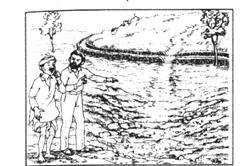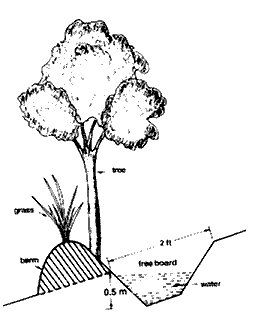/topics/surface-water
Surface Water
The how and why of tank restoration
Posted on 15 Sep, 2009 02:19 PMWhere possible, it is much more cost effective to restore existing tanks, than to build new tanks. Restoration can involve silt removal to increase the storage capacity of the tank and reduce evaporative loss. The silt can be used to restore the earthen bund, and any remaining silt can be applied to nearby farmland. The outflow structure can also be improved.
Tank Development - Design and features
Posted on 15 Sep, 2009 02:11 PMIf the intention is to develop a tank by holding back a large amount of water, then the dam must be carefully designed (with the assistance of experienced local people or engineers).
How to create check dams for water conservation
Posted on 15 Sep, 2009 01:07 PMIn addition to controlling gully erosion, check dams also serve to slow the movement of water, allowing increased percolation into the soil. Just above a check dam is a good place to put in a percolation structure. Silt that builds up behind the dam creates good farmland, which can be planted after the rains while it retains moisture. The following series of pictures show one farmer’s success with building a percolation tank just upstream of a series of check-dams.
How to control gully erosion
Posted on 15 Sep, 2009 12:58 PM Over the years, unchecked soil erosion can lead to the formation of deeper and deeper gullies. There are several methods for controlling gully erosion, which can be chosen depending on the materials available.
Over the years, unchecked soil erosion can lead to the formation of deeper and deeper gullies. There are several methods for controlling gully erosion, which can be chosen depending on the materials available.
If it is a small gully, vegetation can be planted in strips across the gully to slow the velocity of water, trap silt, and prevent further erosion.
Techniques to slow runoff and erosion from steeply sloping land
Posted on 15 Sep, 2009 12:37 PM These techniques are useful to slow runoff and erosion from sloping land, and also to revegetate degraded areas. Areas with high rainfall, steep slopes, and thin soils should use slightly graded bunds / terraces / trenches to allow some drainage.
These techniques are useful to slow runoff and erosion from sloping land, and also to revegetate degraded areas. Areas with high rainfall, steep slopes, and thin soils should use slightly graded bunds / terraces / trenches to allow some drainage.
Tips for using bunds in cultivated Land
Posted on 15 Sep, 2009 12:06 PMBunds have many benefits, including marking the boundaries of farm-holdings, slowing the movement of soil and water, and providing a place for integrating trees into agricultural systems. Here are some tips for using bunds within farmland:
- Cattle should be kept away from the area while establishing saplings, by using livehedge fencing. Cactus, Euphorbia spp, and Agave are useful for a livehedge fence.
- Larger trees can be planted on boundary bunds, and smaller trees which will be harvested more frequently can be planted on internal bunds, which divide one holding into separate sections.
Save Ganga Movement- An initiative to protect river Ganga
Posted on 04 Sep, 2009 05:58 PMMany NGOs are working along with communities and industries to save rivers in India. The river Ganga is relevant culturally, and its waters have been used extensively by industries and communities. At the same time, industrial and agricultural discharge or waste is being dumped at many stretches.
The Arkavathi Integrated Water Resource Management (IWRM) project
Posted on 04 Sep, 2009 05:22 PMThe Arkavathi programme interlinks communities that have been traditionally independent from one another. The Arkavathi River is one of the principal tributaries of the Cauvery in Karnataka and flows through Rural, Peri - Urban and Urban areas.
Integrated approaches for sustainable development in water resources sector
Posted on 04 Sep, 2009 12:11 PMThe Indian Institute of Technology, Madras, Technology for Sustainable Development and the Ecole Polytechnique Federale de Lausanne EPFL have produced a report titled Integrated Approaches for Sustainable Development in Water Resources Sector.
Maps on water quality
Posted on 04 Sep, 2009 11:07 AMThe Environmental Information Centre & Maharashtra Pollution Control Board has prepared water quality monitoring maps that, at a glance, reflects the various water sources and their locations.





